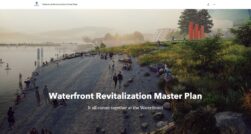Recovery and Revitalization in Mission’s Waterfront

The Waterfront Revitalization Master Plan (WRMP) is a strategic plan for a large-scale community development project focused on recovering, repurposing, and rebuilding the largest underdeveloped area of Fraser River frontage in BC’s Lower Mainland. Mission’s Waterfront Revitalization area spans 3.5 km of river frontage and 296 acres of land and consists of 88 landowners. This exciting revitalization project sets the stage for transformational growth in the creation of a new, innovative, and world-class waterfront community designed to carefully balance residential development with commercial, industrial and institutional development, creating opportunity for employment and job creation today and tomorrow. Ultimately, the WRMP is the roadmap to deliver jobs, a renewed urban core, and new natural spaces along the Fraser River for all to access and enjoy.
To ensure the lands encompassed within the project area are developed in a planned, purposeful, and organized way, the WRMP was produced and subsequently adopted into Mission’s OCP in July 2022. The WRMP is a set of strategies designed to work together, interweaving policy, partnerships, and infrastructure solutions to create a resilient approach to how the waterfront area will be recovered and rebuilt to grow and develop over the next 40 years. It also acts as a guide to collectively address the multiple challenges associated with this project which make it too challenging to be undertaken by independent landowners.
In addition to addressing the community’s land-base needs, returning riverbanks and creeks to their natural function throughout the WRMP will also contribute to long-term ecological integrity, improve climate change resiliency, and restore Mission’s interface with the Fraser River closer to its historic state. This approach to restoration will also help protect the river’s native fish species, including the sturgeon and salmon. Fishing holds a special economic, social, and ceremonial significance to members of the Stó:lō Nation and ensuring continued access to the river in Mission’s waterfront for First Nations fisheries is a part of ongoing reconciliation.
The WRMP was developed in close collaboration with Council, local First Nations, landowners, community stakeholders, and the residents of Mission through public engagement over three phases: realizing the vision, developing site concepts, and confirming the draft plan. This allowed for feedback throughout the development of the WRMP from a high-level vision to detailed direction. First Nations engagement occurred separately from general public engagement, reflecting the unique histories and relationship the City has with local First Nations. To create accessible, transparent, interesting, and relevant engagement, several different forums and forms were available – public surveys (paper and online), webinars, stakeholder workshops, discussion guides, and social media. Over the course of all three engagement phases the project team received in excess of 12,500 unique project website visits, 1,600 survey responses, and dozens of webinars and stakeholder workshop attendees.
Waterfront revitalization is a complex and multi-faceted endeavor. The most important facet in the development and implementation of the WRMP was identifying solutions to overcome the area’s technical challenges including flood protection, land assembly, infrastructure development, and highway alignment. Currently, work is underway and progress being made related to these challenges, along with updated marketing strategies to inform the project’s progress, update anticipated timelines, and keep the project within the investment community’s purview through video production, engagement events and opportunities, and interpretive signage in the area.
Supporting Materials




